 Part 2. For more than 30 years, Jim Kempes taught multiple annual seminars, and was listed in Ghost Ranch seminar brochures as “Potter and Sculptor, Abiquiu, NM,” and as “Ghost Ranch Ceramics Program Coordinator.” In 1983, I took Raku with Jim. Later, with spouse JB, we attended more clay seminars over the years with Jim – our last in 2004, Raku Kiln-building. The legacy of the first 30 years of ceramics programming at the Ranch, as well as Jim’s effectiveness as a teacher are what prompted me to conduct this interview. Enthusiastic listening, equanimity, wide knowledge base, use of questions, and great verbal directions --- that’s how I remember his teaching style. Thanks to Lesley Poling-Kempes for the bio info. -Cirrelda Snider-Bryan, Editor.
Part 2. For more than 30 years, Jim Kempes taught multiple annual seminars, and was listed in Ghost Ranch seminar brochures as “Potter and Sculptor, Abiquiu, NM,” and as “Ghost Ranch Ceramics Program Coordinator.” In 1983, I took Raku with Jim. Later, with spouse JB, we attended more clay seminars over the years with Jim – our last in 2004, Raku Kiln-building. The legacy of the first 30 years of ceramics programming at the Ranch, as well as Jim’s effectiveness as a teacher are what prompted me to conduct this interview. Enthusiastic listening, equanimity, wide knowledge base, use of questions, and great verbal directions --- that’s how I remember his teaching style. Thanks to Lesley Poling-Kempes for the bio info. -Cirrelda Snider-Bryan, Editor.
TST: Tell us more about the artist/teachers you taught with. Who were the other ceramics teachers that presented seminars too?
Jim Kempes: Willard (Spence) was just great. He used to always divide people up: well, are you a fireman, or are you a mud worker? He was both. I felt I was both. You love the science of kiln firing, and mixing glazes and experimenting, and the making of the clay was always pretty neat. He spans both of those. I was just out with somebody hiking and their spouse was taking pottery at Baca Street Pottery in Santa Fe. He said he went in and tried to learn kiln firing and help the guy fire. And he said it was just way beyond his awareness. He would be looking at the color of the flame and the back structure, the cones. That meant stuff to him. That’s the way Willard taught. Willard fired the kiln and he taught me to fire the kiln. Very hands-on, very much you paying attention. He would keep a kiln log that was pretty detailed. Very involved, hands-on firing.
And Joe Mann, he knew Willard’s wife, Louise, who was a potter. Because of that, Joe would come up and help with Crystalline Glazes all the time. That was his thing. Great guy. Helped everybody, including me.
Marie Tapp, remember Marie? She was a potter from the Northwest very talented wheel worker, big platters. She came down and would help Festival of the Arts for a few years.
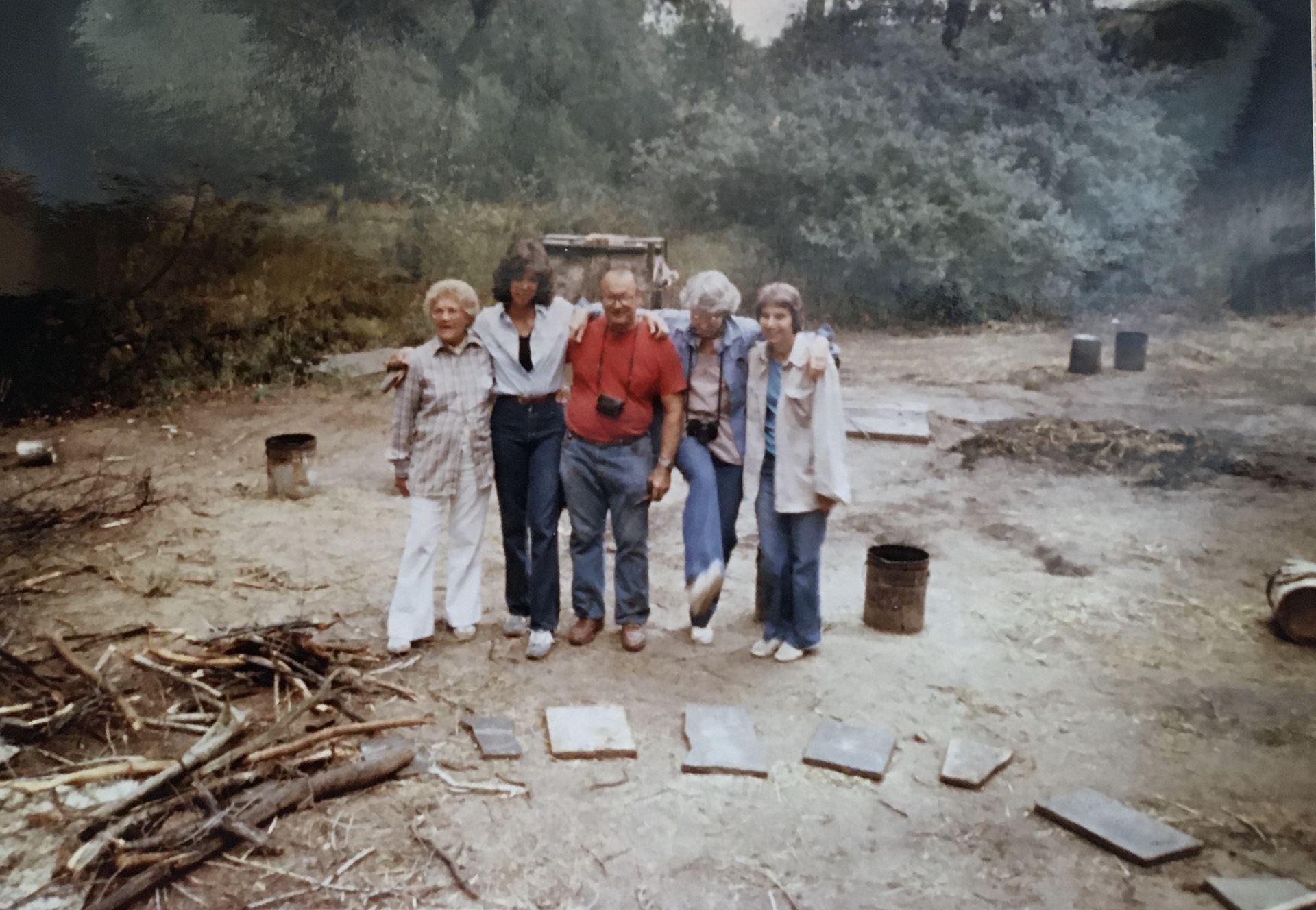
[Alice Bunch, Kathy Gavin, Dick McCarty, Marie Tapp, unknown -- at Raku, 1983. Photo by Cirrelda Snider-Bryan]
Camilla Trujillo, she stepped in to do Pit Fire, though she renamed it “Micaceous Pottery.” She took Pot Hollow totally her own direction, so that was pretty neat. She would be there and I would be on the other side doing Stone Carving or something like that.
Earl and Sylvia Deaver. Did you ever work with them? They were from Texas and they were production potters and crafts people. They were just down-to-earth, they would do service corps, and Earl came in and said, you know I built these ceramic fiber raku kilns, is there any interest in doing a seminar in raku kiln-building? I ran it by it would have been Dean Lewis back then I think, we came up with a cheap price, and had that seminar going for maybe 4 or 5 years, I think. They were great. And they were good friends with the Mackey’s who led Service Corps. That’s Ghost Ranch, it’s these connections that were pretty neat.
It was sort of a relief to get those fiber kilns, we had two of them that we built for the Ranch. So along with that giant trolley kiln, we could use those fiber kilns. And we did a lot of really crazy stuff with that. We would take some of the cone 10 porcelain crystals from a previous seminar and put those in and reduce them and turn a copper green into a copper red, which was pretty cool.
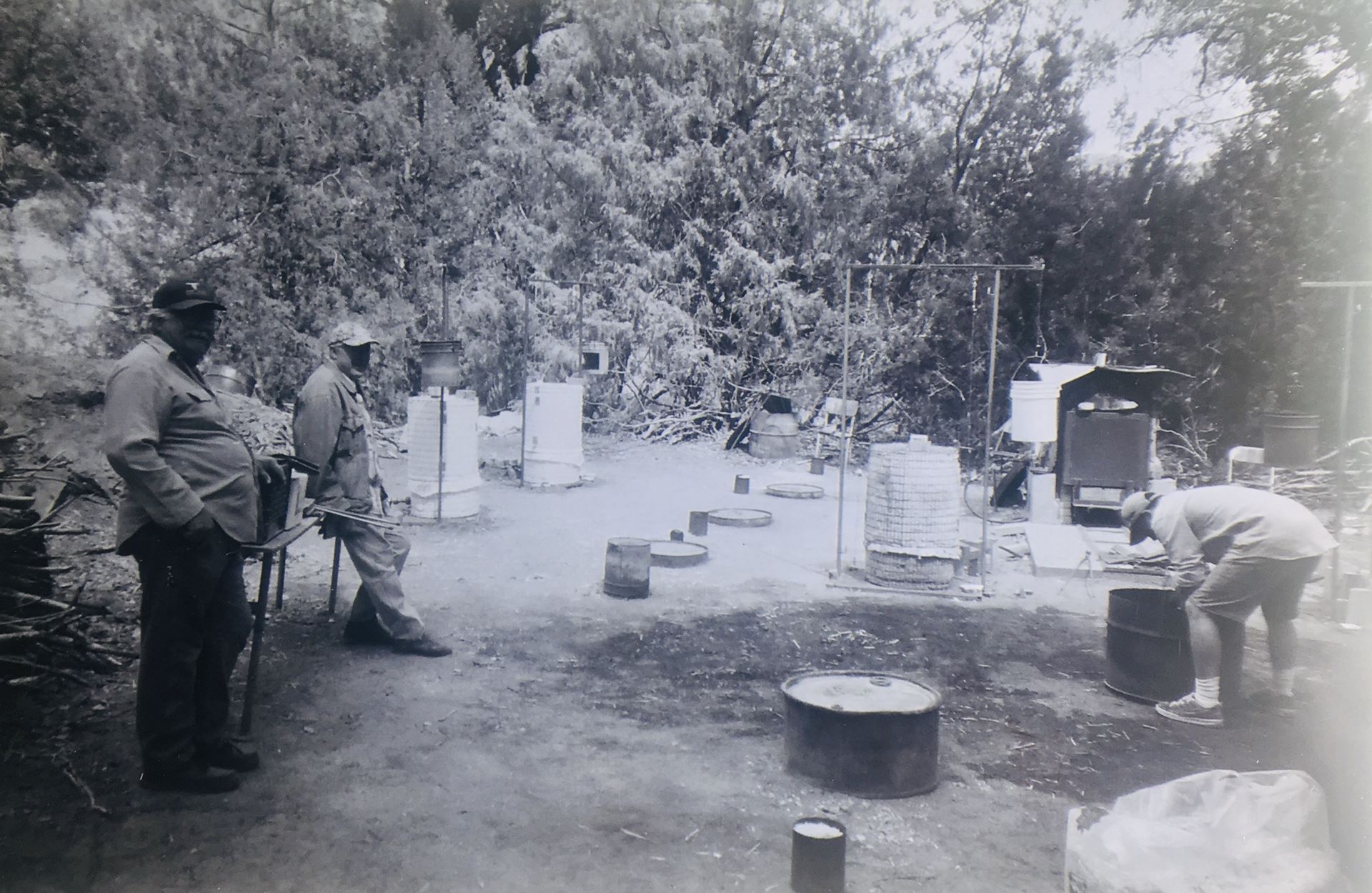
[Earl Deaver, JB Bryan, unknown, with raku fiber kilns at 2004 Raku Kiln Building workshop. Photo by Cirrelda Snider-Bryan.]
And we had Clint Swink come in. Clint is from Bayfield, CO. He was meticulous. He was an ex-military helicopter pilot, and he did ceramics that way. You did it a specific way, you did not put a Kokopelli on a Mesa Verde black and white pot. You had to find that in the book, and make sure you were doing a replica.
TST: Didn’t you and Bill Armstrong and Willard do Adventures in Clay Materials, at least twice?
Jim Kempes: I think that was about it. The people who came to Ghost Ranch, you know sometimes it was a vacation. They had sort of a set need, and the Ceramic Materials, it was a little more esoteric.
But that was always a passion of Willard’s. Many a clay trip with Willard, driving around northern NM and hunting for kaolin, or some kind of clay. And we would go up to Canjillon, and find and test high fire clays, glaze materials, and it was always fun to do. Our Pit Firing seminars, we would always go out to one of the red hills at Ghost Ranch and dig the clay there. The first day would be screening and weighing and mixing up that clay.
Jim Kempes: Felipe Ortega is one that certainly needs to be mentioned. Felipe, you know, great, micaceous, Jicarilla Apache style potter who came over from La Madera. He came in and taught some of the Folk Arts, before Camilla. Accomplished master potter in micaceous work. Workshops at his place in La Madera -- that’s what he will be remembered for. His willingness to share that with people. His neck of the woods, where those clay deposits were. His pit firings with micaceous were just awesome. His humor and flamboyant personality made his teaching one-of-a-kind. And Dennis and Ofelia Jaramillo, they were Felipe’s aunt and uncle -- they lived in La Madera too, and they would come over and we would teach Elder Hostels together, with Dennis and Ofelia. And they were just so wonderful. And they would bring the micaceous clay. We would work with some of the Ghost Ranch clays, the red and black, and they would have the micaceous. We were always of the opinion that it was better to teach too much than too little. We packed it in.
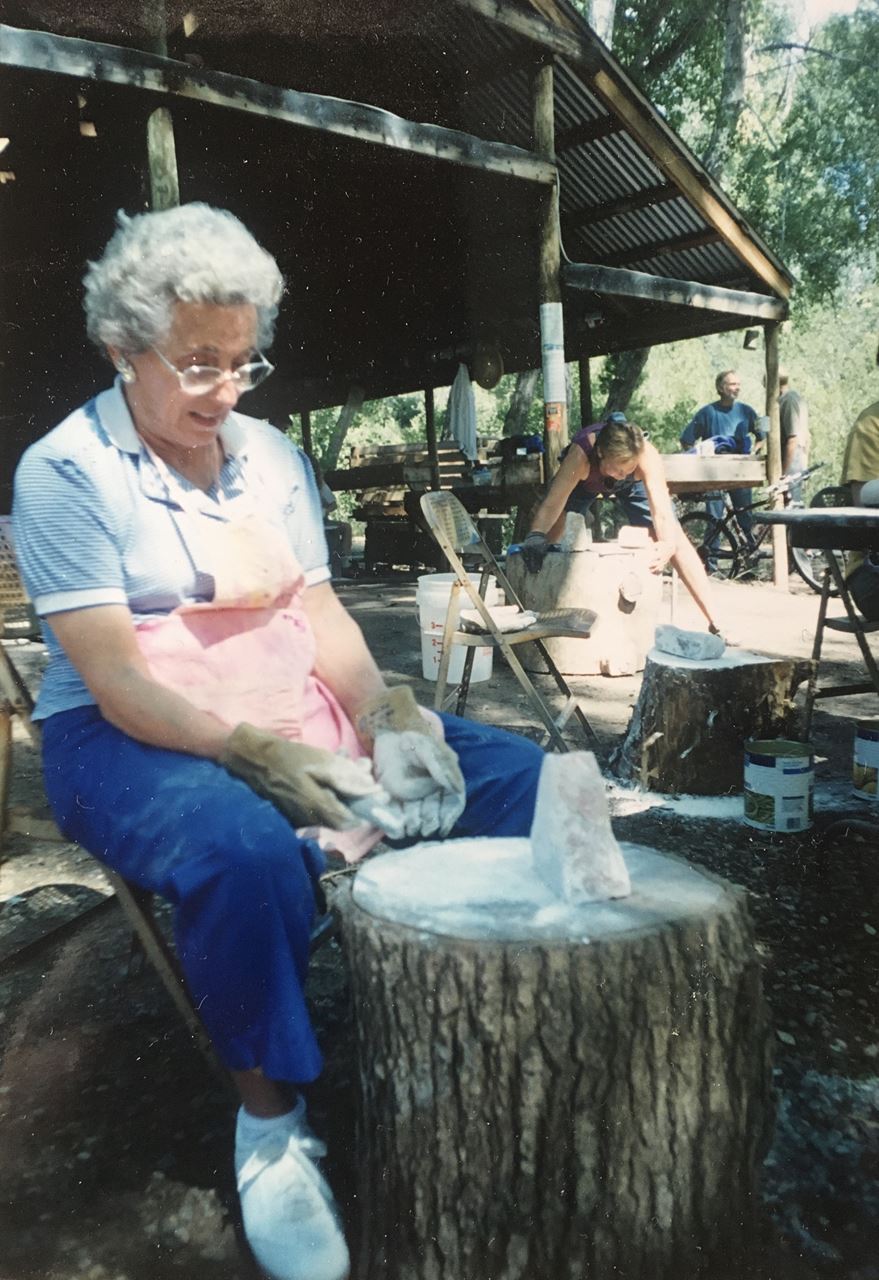
[Molly Bryan, Robin Keck near Pole Barn, Jim Kempes upper right corner, Stone Carving 1999. Photo by Cirrelda Snider-Bryan.]
You have to remember that Stone Carving then got passed off to Robin Keck. She used to take the classes. She does program now at Ghost Ranch. She was one of the students who would come every year. She taught it after I left. That’s sort of the same thing with Barbara Campbell. Barbara hadn’t taught there before. You know she would come in with the Potters Association. And when I left, Barbara stepped in to that position. And that was very successful.
One thing I was laughing about was Willard’s electric kiln, which was custom built, I think it had 12 switches, plus two bottom, plus two elements per switch. And it was an on/off switch there was no re-istat. And all the way up the drying phases. I had a nice little truck that I could put my sleeping bag in the back. I would just sleep down there in Pot Hollow in the back of my truck. One student, once I was telling him I was amazed at my brain I could just say I should get up at two o’clock to check the kiln and do other stuff. And sure enough, I’d wake up at 2 o’clock all the time. And this guy said, “I can do the same thing. If I want to get up at two, I drink one glass of water, if I want to get up earlier, I’d drink two glasses of water.” I thought that was pretty funny.
Willard’s kiln – that electric - was such a thing to fire. My last year there we finally ordered a computerized kiln. And it came in just as I left, so I do not think I ever fired the computerized kiln.
TST: You experienced lots of flooding over the years in Pot Hollow, right? Do you remember the annual monsoon seasons and the arroyo raging out beyond the kilns there?
Jim Kempes: There were couple times, maybe two or three over a summer, where a storm would park in the right place, and that arroyo would just rip. And there were times when it came very close. The raku kiln was the lowest one, and it came close to it. But it never did come over that bank, though it came close to coming over. We went down and looked at it. Actually, there was a time a hiker was on the other side and came back down through Pot Hollow. And the arroyo was still pretty high, and we said you’re gonna have to wait, just wait a half hour or so, you’ll be fine.
TST: I have memories – it would be raging. If you would have a kayak on it, it would be ranked a number 5 or 6 rapid.
Jim Kempes: The memories of Pot Hollow. Pot Hollow was such a delightful place. I mean, we would have Coopers Hawks that would set up their nests down there when there was nobody there in the spring. And then all of a sudden there would be these seminars and we would watch these fledgling Coopers Hawks. It was nice.
TST: Coopers are Accipiter hawks, they have shorter wings, longer tails to maneuver in forests like down in the arroyo. What about swallows?
Jim Kempes: Only on rest of Ranch, not down in Pot Hollow.
TST: I remember Tiger Swallowtail butterflies, too. Something else, do you remember that piece of wood that was carved like a whale, that was at the end of the roof over Pot Hollow?
Jim Kempes: Was that Ed Kraus or was that Jim Connor? We were in that stage of building that, we would build out a little farther, then out a little farther, a couple more years, so there was that one rafter that was sticking out there. Maybe it was Jim Connor. Said, “That looks like a whale.” So, all of a sudden somebody cut a tail and put it up there, and it was with us for a while.
TST: “The” Jim Connor huh. Wow. I’ve heard about him, a lot of people know him, but I don’t. I guess we’ve covered how a lot of new approaches got adopted.
Jim Kempes: Except for two very important things: Mountain Biking seminar, and Cross-Country Skiing seminar.
TST: Let’s hear about those!
Jim Kempes: Isn’t that fun? Yeah. You know this is what I do. So, Chip Meneley was a College Staffer and he went to bike shops in Albuquerque, so he got me into mountain biking. And Geoff Mather, who’s now on the board, was an avid mountain biker and bicyclist from Chicago. We started a seminar and Robin Keck was in that seminar. We would have maybe 10 people, and we would go all over northern New Mexico and do wonderful mountain biking rides. And then usually go and eat somewhere, nice restaurant, to replenish the calories we had burned off. We did that, five years or so, in the fall just as the colors were turning. Real fun. Cross-Country Ski seminars a couple of years, with Paul Graham from Los Alamos. We would do the same thing, same format, we would go out, ski (snow shoes weren’t really catching on yet), we would cross-country ski. I just had to throw that in.
TST: Glad you threw that in, important for us to have that on our radar. Looking back, did you have one course that you looked forward to teaching more than the others?
Jim Kempes: Favorite classes, the ones I looked forward to. You know, Cirrelda, I just have that kind of personality where what I’m doing is what I like doing, ‘til I’m done. So, every class had its real fun, positive aspect, so I mean when you were doing that, it was great. Raku was so dynamic, and people are doing things that are pushing their limits a whole lot. That was just a blast. You know, the unpredictability. You’re asking people to do things that they’ve never done before and they did just great. Over and over and over again, we had successful classes. It was a lot of work. Raku, it would kill me, man, I would finish that thing and I’d go home and leave my clothes out on the porch. Just crashed, ‘cause it was so much. Stoneware, stoneware was delightful. People would have to stay until Monday morning to unload the kiln, and if you were ever around right after breakfast, before breakfast, as we opened the door, and cracked the kiln, started looking in, it was just this beehive of activity and comments as people brought these pieces out. So, that was always a real treat to do, Stoneware. And Crystalline, same thing. That sort of alchemy.
TST: I actually remember loading the kiln. I remember the straight edge with kiln posts, you had it out on the table so that people would pass their piece under it to make sure it would fit on that shelf.
Jim Kempes: “Do the limbo.” All these people, just working together, organizing, doing things so well as a group was one of the strengths of Pot Hollow. Always delightful. And, you would have those students who came back year after year, and they became the teachers, helping others, figuring out, explaining what we were doing and why. That’s why it was so successful. Everybody pitched in.
TST: So, you had no real favorite. I remember you during those Crystalline days, you had a really great knack for talking people through throwing. Somewhere in some journal I took notes of all of your words. You were a great “throwing teacher.” You had really good words. You maybe didn’t realize it when you were a youth, looking at careers, but you were a natural teacher.
Jim Kempes: Well, you want somebody to be successful, right? We laugh about Raku-every-year, Stoneware-every-year -- same thing every year, but every class is different. If you’re on the ball, you have to be looking at what that student needs, and what they’re doing right, and what they need to be corrected and that’s the challenge, that’s what made it fun for so many years. The newness of it.
TST: The newness of each group made each year, each different program enjoyable, so that you can’t really say a favorite.
Jim Kempes: Yeah, and then you would have, tied in with that, those Monday nights you would see who of the old-timers was coming back. And they were going to be the support staff and help everybody. Alice Bunch. You remember Alice?
TST: I sure do! She was my roommate, in the Casitas, and it was 1983. And Alice, did she come for more than Raku?
Jim Kempes: I think it was always Raku. She was so talented. So willing to share, all her information. Yeah, she was great.
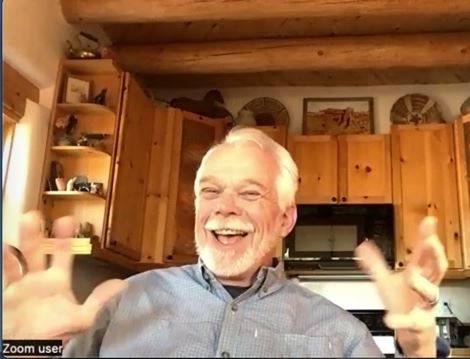
[Jim during the Zoom interview – 12/8/22. Photo by Cirrelda Snider-Bryan.]
TST: Please tell about your current practice. Now that you’re retired, are you in your studio?
Jim Kempes: I am. It’s got its own rhythm, it’s real nice. Winter, you know January, February, I will do wheel work. Nice time to be inside with a wood stove, solar adobe studio. I throw myself into a couple months of wheel work and then that takes its rhythm of glazing, a part of my personality that really gets answered by doing that. And I do a lot of small, functional bowls and things like that. At the Ranch, I had the big stoneware kiln, it was 44” high. My sculptures were pretty large. And Nature has a way, ‘cause I try to move those now, and it’s like, man, how did I ever get that in the kiln? So now I just have a little electric that’s 24” tall, and I didn’t think I wanted to do my sculpture shapes in that range. But my son came up and Christopher said, “Dad, why don’t you teach me how to coil.” So, I took him through a couple of coil pots to show him how to do that and did a couple myself. You know, this is okay, this is going to work. So, I’ve been doing coil pots on that smaller range, and a lot of them are still the abstractions of “manos,” and “metates,” chips, axe heads, Corn Mothers, and different shapes that you see around this area. Some are real smooth finish. I’ve got a nice stamp that I made off of a “mano,” that I can press in as I’m making the pot and it gives me a perfect basalt texture. So, I spray glaze on it. I am having a great time with that. I do stone work. I do little alabaster pieces. I still work with that. I do some larger pieces (you know this [showing 18-20”] to me is large! [chuckles] Larger pieces of marble and flagstone from out at Blackie’s 2 ft by 2 ft or so. Stone gets heavy fast. And so yeah, I will do that, with grinders and work on that. Through the pandemic I started taking my wheelbarrow up into the arroyo and finding nice basalt boulders, and wheel them back, and then using grinders and diamond bits, pneumatic hammer drills, turning those into “tinajas,” basins. That’s been fun to work with these abstract shapes. And then that went vertical and started doing the holes all the way through, and sort of doing a “window” rock. So those are the areas that I’ve done. Then I do one for a month or two, move on to another area. And then I have to mix my adventure things with that.
TST: After the cold months. This has been really wonderful Jim. I can tell you’ve really been thinking about this. I appreciate your thoughtfulness and your details.
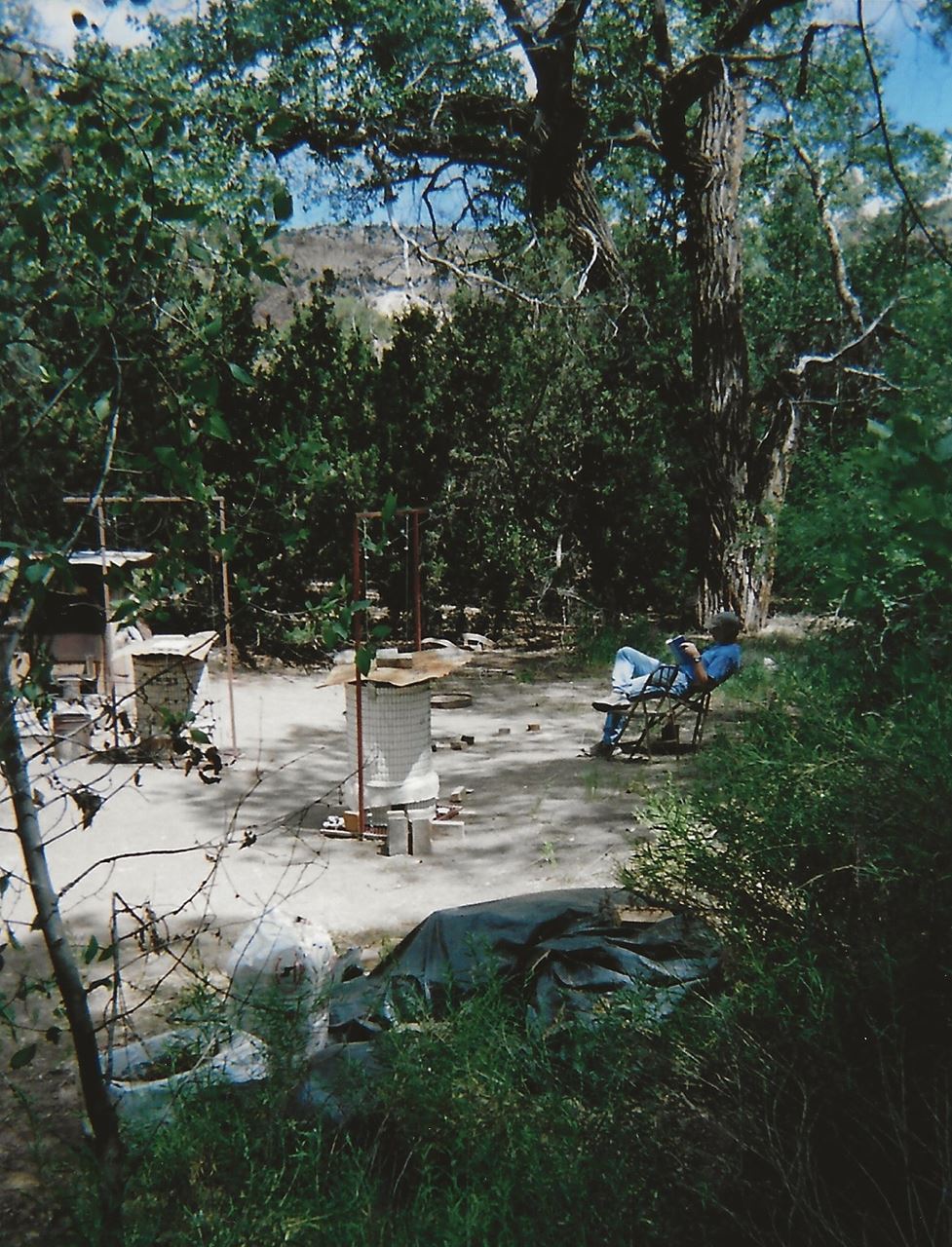 [Catching the pottery teacher having a solitary moment in Pot Hollow, summer 2003. Photo by Cirrelda Snider-Bryan.]
[Catching the pottery teacher having a solitary moment in Pot Hollow, summer 2003. Photo by Cirrelda Snider-Bryan.]


